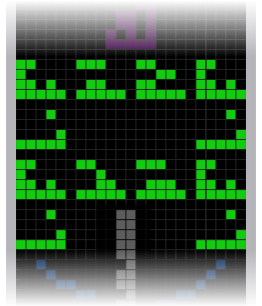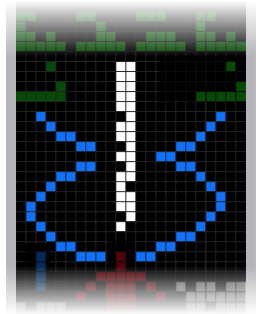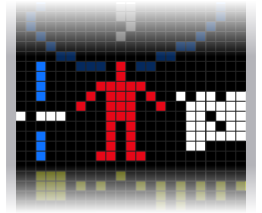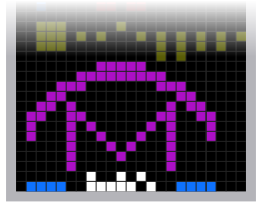
Arecibo message
Encyclopedia

Broadcasting
Broadcasting is the distribution of audio and video content to a dispersed audience via any audio visual medium. Receiving parties may include the general public or a relatively large subset of thereof...
into space a single time via frequency modulated
Frequency modulation
In telecommunications and signal processing, frequency modulation conveys information over a carrier wave by varying its instantaneous frequency. This contrasts with amplitude modulation, in which the amplitude of the carrier is varied while its frequency remains constant...
radio waves
Radio waves
Radio waves are a type of electromagnetic radiation with wavelengths in the electromagnetic spectrum longer than infrared light. Radio waves have frequencies from 300 GHz to as low as 3 kHz, and corresponding wavelengths from 1 millimeter to 100 kilometers. Like all other electromagnetic waves,...
at a ceremony to mark the remodeling of the Arecibo radio telescope
Arecibo Observatory
The Arecibo Observatory is a radio telescope near the city of Arecibo in Puerto Rico. It is operated by SRI International under cooperative agreement with the National Science Foundation...
on 16 November 1974. It was aimed at the globular star cluster M13 some 25,000 light years away because M13 was a large and close collection of stars that was available in the sky at the time and place of the ceremony. The message consisted of 1679 binary digits
Bit
A bit is the basic unit of information in computing and telecommunications; it is the amount of information stored by a digital device or other physical system that exists in one of two possible distinct states...
, approximately 210 byte
Byte
The byte is a unit of digital information in computing and telecommunications that most commonly consists of eight bits. Historically, a byte was the number of bits used to encode a single character of text in a computer and for this reason it is the basic addressable element in many computer...
s, transmitted at a frequency of 2380 MHz
Hertz
The hertz is the SI unit of frequency defined as the number of cycles per second of a periodic phenomenon. One of its most common uses is the description of the sine wave, particularly those used in radio and audio applications....
and modulated by shifting the frequency by 10 Hz, with a power of 1000 kW. The "ones" and "zeros" were transmitted by frequency shifting at the rate of 10 bits per second. The total broadcast was less than three minutes.
The cardinality of 1679 was chosen because it is a semiprime
Semiprime
In mathematics, a semiprime is a natural number that is the product of two prime numbers. The first few semiprimes are 4, 6, 9, 10, 14, 15, 21, 22, 25, 26, ... ....
(the product of two prime number
Prime number
A prime number is a natural number greater than 1 that has no positive divisors other than 1 and itself. A natural number greater than 1 that is not a prime number is called a composite number. For example 5 is prime, as only 1 and 5 divide it, whereas 6 is composite, since it has the divisors 2...
s), to be arranged rectangularly
Raster scan
A raster scan, or raster scanning, is the rectangular pattern of image capture and reconstruction in television. By analogy, the term is used for raster graphics, the pattern of image storage and transmission used in most computer bitmap image systems...
as 73 rows by 23 columns. The alternative arrangement, 23 rows by 73 columns, produces jumbled nonsense. The message forms the image shown on the right, or its inverse, when translated into graphics characters and spaces.
Dr. Frank Drake
Frank Drake
Frank Donald Drake PhD is an American astronomer and astrophysicist. He is most notable as one of the pioneers in the search for extraterrestrial intelligence, including the founding of SETI, mounting the first observational attempts at detecting extraterrestrial communications in 1961 in Project...
, then at Cornell University
Cornell University
Cornell University is an Ivy League university located in Ithaca, New York, United States. It is a private land-grant university, receiving annual funding from the State of New York for certain educational missions...
and creator of the famous Drake equation
Drake equation
The Drake equation is an equation used to estimate the number of detectable extraterrestrial civilizations in the Milky Way galaxy. It is used in the fields of exobiology and the Search for ExtraTerrestrial Intelligence...
, wrote the message, with help from Carl Sagan
Carl Sagan
Carl Edward Sagan was an American astronomer, astrophysicist, cosmologist, author, science popularizer and science communicator in astronomy and natural sciences. He published more than 600 scientific papers and articles and was author, co-author or editor of more than 20 books...
, among others. The message consists of seven parts that encode the following (from the top down):
- The numbers one (1) through ten (10)
- The atomic numbers of the elements hydrogenHydrogenHydrogen is the chemical element with atomic number 1. It is represented by the symbol H. With an average atomic weight of , hydrogen is the lightest and most abundant chemical element, constituting roughly 75% of the Universe's chemical elemental mass. Stars in the main sequence are mainly...
, carbonCarbonCarbon is the chemical element with symbol C and atomic number 6. As a member of group 14 on the periodic table, it is nonmetallic and tetravalent—making four electrons available to form covalent chemical bonds...
, nitrogenNitrogenNitrogen is a chemical element that has the symbol N, atomic number of 7 and atomic mass 14.00674 u. Elemental nitrogen is a colorless, odorless, tasteless, and mostly inert diatomic gas at standard conditions, constituting 78.08% by volume of Earth's atmosphere...
, oxygenOxygenOxygen is the element with atomic number 8 and represented by the symbol O. Its name derives from the Greek roots ὀξύς and -γενής , because at the time of naming, it was mistakenly thought that all acids required oxygen in their composition...
, and phosphorusPhosphorusPhosphorus is the chemical element that has the symbol P and atomic number 15. A multivalent nonmetal of the nitrogen group, phosphorus as a mineral is almost always present in its maximally oxidized state, as inorganic phosphate rocks...
, which make up deoxyribonucleic acid (DNA) - The formulaFormulaIn mathematics, a formula is an entity constructed using the symbols and formation rules of a given logical language....
s for the sugarSugarSugar is a class of edible crystalline carbohydrates, mainly sucrose, lactose, and fructose, characterized by a sweet flavor.Sucrose in its refined form primarily comes from sugar cane and sugar beet...
s and basesBase (chemistry)For the term in genetics, see base A base in chemistry is a substance that can accept hydrogen ions or more generally, donate electron pairs. A soluble base is referred to as an alkali if it contains and releases hydroxide ions quantitatively...
in the nucleotides of DNA - The number of nucleotides in DNA, and a graphic of the double helix structure of DNA
- A graphic figure of a human, the dimension (physical height) of an average man, and the human population of Earth
- A graphic of the Solar SystemSolar SystemThe Solar System consists of the Sun and the astronomical objects gravitationally bound in orbit around it, all of which formed from the collapse of a giant molecular cloud approximately 4.6 billion years ago. The vast majority of the system's mass is in the Sun...
- A graphic of the Arecibo radio telescopeArecibo ObservatoryThe Arecibo Observatory is a radio telescope near the city of Arecibo in Puerto Rico. It is operated by SRI International under cooperative agreement with the National Science Foundation...
and the dimension (the physical diameter) of the transmitting antenna dish
Because it will take 25,000 years for the message to reach its intended destination of stars (and an additional 25,000 years for any reply), the Arecibo message was more a demonstration of human technological achievement than a real attempt to enter into a conversation with extraterrestrials. In fact, the stars of M13 that the message was aimed at will no longer be in that location when the message arrives. According to the Cornell News press release of November 12, 1999, the real purpose of the message was not to make contact, but to demonstrate the capabilities of newly installed equipment.
Numbers

----------------------
0 0 0 1 1 1 1 00 00 00
0 1 1 0 0 1 1 00 00 10
1 0 1 0 1 0 1 01 11 01
X X X X X X X X X X <-least-significant-digit marker
The numbers from 1 to 10
10 (number)
10 is an even natural number following 9 and preceding 11.-In mathematics:Ten is a composite number, its proper divisors being , and...
appear in binary
Binary numeral system
The binary numeral system, or base-2 number system, represents numeric values using two symbols, 0 and 1. More specifically, the usual base-2 system is a positional notation with a radix of 2...
format (the bottom row marks the beginning of each number).
Even assuming that recipients would recognize binary, the encoding of the numbers may not be immediately obvious due to the way they have been written. To read the first seven digits, ignore the bottom row, and read them as three binary digits from top to bottom, with the top digit being the most significant. The readings for 8, 9 and 10 are a little different, as they have been given an additional column next to the first (to the right in the image). This is probably intended to show that numbers too large to fit in a column can be written in several contiguous ones, where the contiguous columns do not have the base marker.
DNA elements

1 6 7 8 15
----------
0 0 0 1 1
0 1 1 0 1
0 1 1 0 1
1 0 1 0 1
X X X X X
The numbers 1, 6, 7, 8 and 15 appear. These are the atomic numbers of hydrogen
Hydrogen
Hydrogen is the chemical element with atomic number 1. It is represented by the symbol H. With an average atomic weight of , hydrogen is the lightest and most abundant chemical element, constituting roughly 75% of the Universe's chemical elemental mass. Stars in the main sequence are mainly...
(H), carbon
Carbon
Carbon is the chemical element with symbol C and atomic number 6. As a member of group 14 on the periodic table, it is nonmetallic and tetravalent—making four electrons available to form covalent chemical bonds...
(C), nitrogen
Nitrogen
Nitrogen is a chemical element that has the symbol N, atomic number of 7 and atomic mass 14.00674 u. Elemental nitrogen is a colorless, odorless, tasteless, and mostly inert diatomic gas at standard conditions, constituting 78.08% by volume of Earth's atmosphere...
(N), oxygen
Oxygen
Oxygen is the element with atomic number 8 and represented by the symbol O. Its name derives from the Greek roots ὀξύς and -γενής , because at the time of naming, it was mistakenly thought that all acids required oxygen in their composition...
(O), and phosphorus
Phosphorus
Phosphorus is the chemical element that has the symbol P and atomic number 15. A multivalent nonmetal of the nitrogen group, phosphorus as a mineral is almost always present in its maximally oxidized state, as inorganic phosphate rocks...
(P), the components of DNA.
The numbers 8 and 15 are written in a logical extension of binary encoding, rather than with the contiguous-columns method shown in the message's number figures at the top.
Nucleotides

Deoxyribose
Deoxyribose, more, precisely 2-deoxyribose, is a monosaccharide with idealized formula H---3-H. Its name indicates that it is a deoxy sugar, meaning that it is derived from the sugar ribose by loss of an oxygen atom...
Adenine
Adenine
Adenine is a nucleobase with a variety of roles in biochemistry including cellular respiration, in the form of both the energy-rich adenosine triphosphate and the cofactors nicotinamide adenine dinucleotide and flavin adenine dinucleotide , and protein synthesis, as a chemical component of DNA...
Thymine
Thymine
Thymine is one of the four nucleobases in the nucleic acid of DNA that are represented by the letters G–C–A–T. The others are adenine, guanine, and cytosine. Thymine is also known as 5-methyluracil, a pyrimidine nucleobase. As the name suggests, thymine may be derived by methylation of uracil at...
Deoxyribose
(C5OH7) (C5H4N5) (C5H5N2O2) (C5OH7)
Phosphate
Phosphate
A phosphate, an inorganic chemical, is a salt of phosphoric acid. In organic chemistry, a phosphate, or organophosphate, is an ester of phosphoric acid. Organic phosphates are important in biochemistry and biogeochemistry or ecology. Inorganic phosphates are mined to obtain phosphorus for use in...
Phosphate
(PO4) (PO4)
Deoxyribose Cytosine
Cytosine
Cytosine is one of the four main bases found in DNA and RNA, along with adenine, guanine, and thymine . It is a pyrimidine derivative, with a heterocyclic aromatic ring and two substituents attached . The nucleoside of cytosine is cytidine...
Guanine
Guanine
Guanine is one of the four main nucleobases found in the nucleic acids DNA and RNA, the others being adenine, cytosine, and thymine . In DNA, guanine is paired with cytosine. With the formula C5H5N5O, guanine is a derivative of purine, consisting of a fused pyrimidine-imidazole ring system with...
Deoxyribose
(C5OH7) (C4H4N3O) (C5H4N5O) (C5OH7)
Phosphate Phosphate
(PO4) (PO4)
The nucleotides are described as sequences of the five atoms that appear on the preceding line. Each sequence represents the molecular formula of the nucleotide as incorporated into DNA (as opposed to the free form of the nucleotide).
For example, deoxyribose (C5OH7 in DNA, C5O4H10 when free), the nucleotide in the top left in the image, is read as:
11000
10000
11010
XXXXX
-----
75010
i.e. 7 atoms of hydrogen, 5 atoms of carbon, 0 atoms of nitrogen, 1 atom of oxygen, and 0 atoms of phosphorus.
Double helix

11
11
11
11
01
11
11
01
11
01
11
10
11
11
01
X
1111111111110111 1111101101011110 (binary)
= 4,294,441,823 (decimal)
DNA double helix
Helix
A helix is a type of smooth space curve, i.e. a curve in three-dimensional space. It has the property that the tangent line at any point makes a constant angle with a fixed line called the axis. Examples of helixes are coil springs and the handrails of spiral staircases. A "filled-in" helix – for...
(the vertical bar represents the number of nucleotides, but the value depicted is around 4.3 billion when in fact there are about 3.2 billion base pairs in the human genome).
Humanity

111111
X0111 110111
111011
111111
110000
1110 (binary) = 14 (decimal)
000011 111111 110111 111011 111111 110110 (binary)
= 4,292,853,750 (decimal)
The element in the center represents a human. The element on the left (in the image) indicates the average height of an adult male: 1764 mm. This corresponds to the horizontally written binary 14 multiplied by the wavelength
Wavelength
In physics, the wavelength of a sinusoidal wave is the spatial period of the wave—the distance over which the wave's shape repeats.It is usually determined by considering the distance between consecutive corresponding points of the same phase, such as crests, troughs, or zero crossings, and is a...
of the message (126 mm). The element on the right depicts the size of human population in 1974, around 4.3 billion. In this case, the number is oriented horizontally rather than vertically, with the least-significant-digit marker to the upper left in the image.
Planets

Sun Mercury Venus Mars Jupiter Saturn Uranus Neptune Pluto
The solar system
Solar System
The Solar System consists of the Sun and the astronomical objects gravitationally bound in orbit around it, all of which formed from the collapse of a giant molecular cloud approximately 4.6 billion years ago. The vast majority of the system's mass is in the Sun...
, showing the Sun
Sun
The Sun is the star at the center of the Solar System. It is almost perfectly spherical and consists of hot plasma interwoven with magnetic fields...
and the planets in the order of their position from the Sun
Sun
The Sun is the star at the center of the Solar System. It is almost perfectly spherical and consists of hot plasma interwoven with magnetic fields...
: Mercury
Mercury (planet)
Mercury is the innermost and smallest planet in the Solar System, orbiting the Sun once every 87.969 Earth days. The orbit of Mercury has the highest eccentricity of all the Solar System planets, and it has the smallest axial tilt. It completes three rotations about its axis for every two orbits...
, Venus
Venus
Venus is the second planet from the Sun, orbiting it every 224.7 Earth days. The planet is named after Venus, the Roman goddess of love and beauty. After the Moon, it is the brightest natural object in the night sky, reaching an apparent magnitude of −4.6, bright enough to cast shadows...
, Earth
Earth
Earth is the third planet from the Sun, and the densest and fifth-largest of the eight planets in the Solar System. It is also the largest of the Solar System's four terrestrial planets...
, Mars
Mars
Mars is the fourth planet from the Sun in the Solar System. The planet is named after the Roman god of war, Mars. It is often described as the "Red Planet", as the iron oxide prevalent on its surface gives it a reddish appearance...
, Jupiter
Jupiter
Jupiter is the fifth planet from the Sun and the largest planet within the Solar System. It is a gas giant with mass one-thousandth that of the Sun but is two and a half times the mass of all the other planets in our Solar System combined. Jupiter is classified as a gas giant along with Saturn,...
, Saturn
Saturn
Saturn is the sixth planet from the Sun and the second largest planet in the Solar System, after Jupiter. Saturn is named after the Roman god Saturn, equated to the Greek Cronus , the Babylonian Ninurta and the Hindu Shani. Saturn's astronomical symbol represents the Roman god's sickle.Saturn,...
, Uranus
Uranus
Uranus is the seventh planet from the Sun. It has the third-largest planetary radius and fourth-largest planetary mass in the Solar System. It is named after the ancient Greek deity of the sky Uranus , the father of Cronus and grandfather of Zeus...
, Neptune
Neptune
Neptune is the eighth and farthest planet from the Sun in the Solar System. Named for the Roman god of the sea, it is the fourth-largest planet by diameter and the third largest by mass. Neptune is 17 times the mass of Earth and is slightly more massive than its near-twin Uranus, which is 15 times...
, and Pluto
Pluto
Pluto, formal designation 134340 Pluto, is the second-most-massive known dwarf planet in the Solar System and the tenth-most-massive body observed directly orbiting the Sun...
. (Pluto has since been reclassified as a dwarf planet
Dwarf planet
A dwarf planet, as defined by the International Astronomical Union , is a celestial body orbiting the Sun that is massive enough to be spherical as a result of its own gravity but has not cleared its neighboring region of planetesimals and is not a satellite...
by the International Astronomical Union
International Astronomical Union
The International Astronomical Union IAU is a collection of professional astronomers, at the Ph.D. level and beyond, active in professional research and education in astronomy...
, but it was still considered a planet at the time the message was transmitted.)
The Earth is the third planet from the Sun
Sun
The Sun is the star at the center of the Solar System. It is almost perfectly spherical and consists of hot plasma interwoven with magnetic fields...
- its graphic is shifted up to identify it as the planet from where the signal was sent. Additionally the human figure is shown "standing on" the Earth graphic.
In addition to showing position, the graphic provides a general, not-to-scale size reference of each planet and the Sun.
Telescope

100101
<--- 111110X --->
100101 111110 (binary) = 2,430 (decimal)
The last part represents the Arecibo radio telescope with its diameter
Diameter
In geometry, a diameter of a circle is any straight line segment that passes through the center of the circle and whose endpoints are on the circle. The diameters are the longest chords of the circle...
(2430 multiplied by the wavelength gives 306.18 m). In this case, the number is oriented horizontally, with the least-significant-digit marker to the lower right in the image.
Message as binary string
0000001010101000000000000101000001010000000100
10001000100010010110010
10101010101010100100100
00000000000000000000000
00000000000011000000000
00000000001101000000000
00000000001101000000000
00000000010101000000000
00000000011111000000000
00000000000000000000000
11000011100011000011000
10000000000000110010000
11010001100011000011010
11111011111011111011111
00000000000000000000000
00010000000000000000010
00000000000000000000000
00001000000000000000001
11111000000000000011111
00000000000000000000000
11000011000011100011000
10000000100000000010000
11010000110001110011010
11111011111011111011111
00000000000000000000000
00010000001100000000010
00000000001100000000000
00001000001100000000001
11111000001100000011111
00000000001100000000000
00100000000100000000100
00010000001100000001000
00001100001100000010000
00000011000100001100000
00000000001100110000000
00000011000100001100000
00001100001100000010000
00010000001000000001000
00100000001100000000100
01000000001100000000100
01000000000100000001000
00100000001000000010000
00010000000000001100000
00001100000000110000000
00100011101011000000000
00100000001000000000000
00100000111110000000000
00100001011101001011011
00000010011100100111111
10111000011100000110111
00000000010100000111011
00100000010100000111111
00100000010100000110000
00100000110110000000000
00000000000000000000000
00111000001000000000000
00111010100010101010101
00111000000000101010100
00000000000000101000000
00000000111110000000000
00000011111111100000000
00001110000000111000000
00011000000000001100000
00110100000000010110000
01100110000000110011000
01000101000001010001000
01000100100010010001000
00000100010100010000000
00000100001000010000000
00000100000000010000000
00000001001010000000000
01111001111101001111000
or

00101000001010000000100
10001000100010010110010
10101010101010100100100
00000000000000000000000
00000000000011000000000
00000000001101000000000
00000000001101000000000
00000000010101000000000
00000000011111000000000
00000000000000000000000
11000011100011000011000
10000000000000110010000
11010001100011000011010
11111011111011111011111
00000000000000000000000
00010000000000000000010
00000000000000000000000
00001000000000000000001
11111000000000000011111
00000000000000000000000
11000011000011100011000
10000000100000000010000
11010000110001110011010
11111011111011111011111
00000000000000000000000
00010000001100000000010
00000000001100000000000
00001000001100000000001
11111000001100000011111
00000000001100000000000
00100000000100000000100
00010000001100000001000
00001100001100000010000
00000011000100001100000
00000000001100110000000
00000011000100001100000
00001100001100000010000
00010000001000000001000
00100000001100000000100
01000000001100000000100
01000000000100000001000
00100000001000000010000
00010000000000001100000
00001100000000110000000
00100011101011000000000
00100000001000000000000
00100000111110000000000
00100001011101001011011
00000010011100100111111
10111000011100000110111
00000000010100000111011
00100000010100000111111
00100000010100000110000
00100000110110000000000
00000000000000000000000
00111000001000000000000
00111010100010101010101
00111000000000101010100
00000000000000101000000
00000000111110000000000
00000011111111100000000
00001110000000111000000
00011000000000001100000
00110100000000010110000
01100110000000110011000
01000101000001010001000
01000100100010010001000
00000100010100010000000
00000100001000010000000
00000100000000010000000
00000001001010000000000
01111001111101001111000
See also
- Cosmic CallCosmic CallCosmic Call was the name of two interstellar radio messages that were sent from RT-70 in Yevpatoria in 1999 and 2003 to various nearby stars. The messages were designed with noise resistant format and characters....
- Wow! signalWow! signalThe Wow! signal was a strong narrowband radio signal detected by Dr. Jerry R. Ehman on August 15, 1977, while working on a SETI project at the Big Ear radio telescope of The Ohio State University then located at Ohio Wesleyan University's Perkins Observatory, Delaware, Ohio. The signal bore...
- Active SETIActive SETIActive SETI is the attempt to send messages to intelligent aliens. Active SETI messages are usually in the form of radio signals. Physical messages like that of the Pioneer plaque may also be considered an active SETI message...
- A Message From EarthA Message From EarthA Message from Earth is a high-powered digital radio signal that was sent on 9 October 2008 towards Gliese 581 c, a large terrestrial extrasolar planet orbiting the red dwarf star Gliese 581. The signal is a digital time capsule containing 501 messages that were selected through a competition on...
- Communication with Extraterrestrial IntelligenceCommunication with Extraterrestrial IntelligenceCommunication with extraterrestrial intelligence is a branch of the search for extraterrestrial intelligence that focuses on composing and deciphering messages that could theoretically be understood by another technological civilization. The best-known CETI experiment was the 1974 Arecibo message...
(CETI) - Pioneer plaquePioneer plaqueThe Pioneer plaques are a pair of gold-anodized aluminium plaques which were placed on board the 1972 Pioneer 10 and 1973 Pioneer 11 spacecraft, featuring a pictorial message, in case either Pioneer 10 or 11 are intercepted by extraterrestrial life...
- Voyager Golden RecordVoyager Golden RecordThe Voyager Golden Records are phonograph records which were included aboard both Voyager spacecraft, which were launched in 1977. They contain sounds and images selected to portray the diversity of life and culture on Earth, and are intended for any intelligent extraterrestrial life form, or for...

